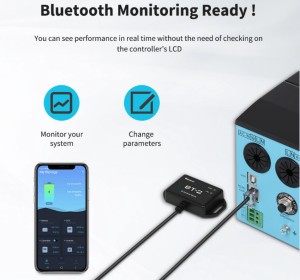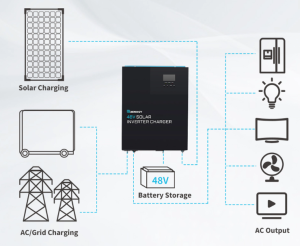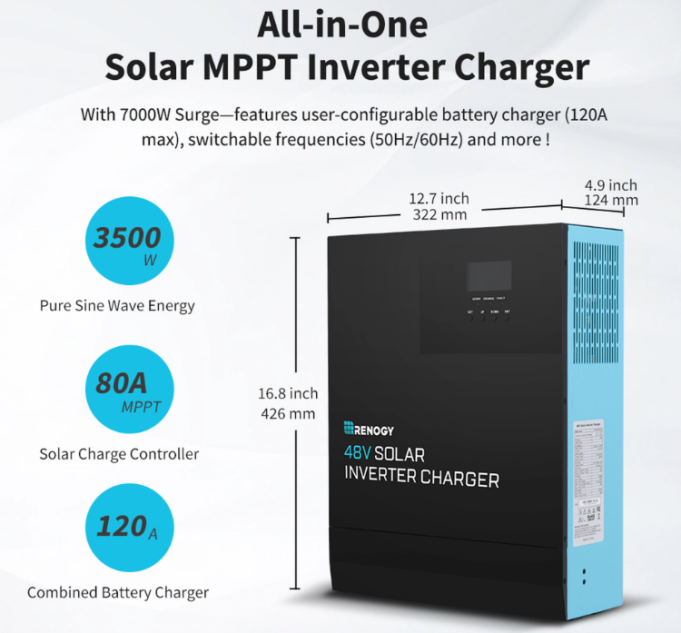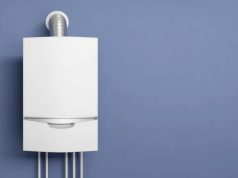In life, we may often come into contact with inverters. But what is an inverter? Many people may not know how it works. The inverter has a significant impact on the efficiency of your photovoltaic system because it converts the direct current generated by the photovoltaic system into usable alternating current. The more efficiently the inverter works, the more solar yield you can use.
But the inverter takes on numerous other tasks. The performance of the photovoltaic system is kept at a maximum by continuously controlling the Maximum Power Point (MPP). In addition, the system yield is continuously monitored and the grid frequency is kept stable. Some inverters even have intelligent energy management that optimizes the performance of the photovoltaic system depending on shading, weather conditions and power consumption in the house.
Important key figures for the inverter test
EFFICIENCY
Probably the most important indicator of an inverter is its efficiency. The efficiency of modern inverters is already very high and is around 96-98%. Inverters without a transformer have an efficiency of around 98%, while inverters with a transformer achieve an efficiency of around 96%. If possible, the European efficiency should be used for comparison, because the European efficiency is more realistic than the ideal efficiency, as it also takes into account the weather conditions typical of the location.
LIFESPAN
The inverter is the shortest-lived component of a photovoltaic system. Its service life is designed for 20 years. The service life of the inverter is an important selection criterion so that the inverter only has to be replaced once during the operating time of the photovoltaic system, which can also exceed 30 years, and ideally not at all. If you choose an inverter that is not too tightly dimensioned, the service life will increase. A cool location of the inverter also has a positive effect on its service life.
NUMBER OF PHASES
There are single-phase and three-phase inverters. Today, three-phase inverters dominate the market, as they enable an even feed into the power grid. In addition, the use of 3-phase inverters has been mandatory since 2012 for systems larger than 4.6 kilovolt amperes (kVA) per phase. With single-phase inverters, there is a risk that the individual household appliances will not be distributed evenly across the mains phases, resulting in asymmetries in the mains voltage.
HYBRID INVERTER YES OR NO?
A hybrid inverter is an inverter with internal or external power storage. That means PV inverter and battery inverter are combined in one device. The advantage: in the event of a power failure or in the event of a lack of solar power, the hybrid inverter can continue to supply the house with electricity. In recent years, the market share of hybrid inverters has increased continuously. A hybrid inverter, while beneficial, isn’t essential, especially if you’re installing power storage anyway.

VOLUME
An solar inverter should not exceed the volume of 55 decibels (equivalent to the volume of a normal conversation), which is pretty important component of a complete off grid solar power system. Some inverters even only reach a volume of around 40 dB. However, it is best to set up the inverter in the basement or in the utility room. In this way you can be sure that the operating noise of the inverter is not disturbing.
PRICE-PERFORMANCE RATIO
Inverters typically cost between $1,000 and $2,500. Higher-priced inverters usually have good efficiency, are compatible with many storage systems and have options for intelligent control and system monitoring. On the other hand, inverters that have fewer special functions should be in the lower price range.
FURTHER CRITERIA
In addition to purely technical criteria, it is also of crucial importance how user-friendly the operation of the inverter is, whether the manufacturer provides a clear monitoring portal or an intelligent energy management system, or whether the inverter offers a high level of operational reliability.
Typical test procedures
In most inverter tests, the performance of an inverter is checked under normal operating conditions. Typical influencing factors such as temperature, humidity or air pressure are varied. Operating parameters such as the input voltage and output power ratios are also modified.
If the service life of an inverter is to be tested, the inverter is operated around the clock for several weeks together with other inverters. Due to rapidly changing climatic conditions, a longer period of time can be simulated and, in comparison with the other inverters, statements about the longevity can be made. If you want to test the volume of an inverter, the volume must be measured in decibels under different operating conditions and external influencing factors.
Known test providers
First of all, of course, the inverter manufacturers themselves carry out tests on their inverters at regular intervals. Since very few manufacturers have their own laboratories for this, they turn to professional test laboratories such as VDE Global Services Augsburg GmbH, which analyzes the service life and reliability of inverters, or Intertek Holding Deutschland GmbH, which tests and certifies all inverter types and sizes according to international safety standards.
There are also some independent providers of inverter tests. Stiftung Warentest, for example, tested common inverters in 2006. The specialist magazine Photon also tests two inverters under laboratory conditions at regular intervals.
Current inverters being tested by Wegatech
Even if we cannot carry out a test under laboratory conditions here, we have examined three of the currently most popular inverters in more detail below.
Renogy 48V 3500W Solar Inverter Charger
【STABLE AND PURE SINE WAVE CHARGING】 3500W continuous, 7000W peak surge during load start-up and combines 80A MPPT solar charging, AC/generator battery charging, and battery inverting into one convenient solution to take your off-grid system to the hybrid level and can turn your system into an uninterruptible power supply (UPS).
【HYBRID SYSTEM 】 Integrated with 80A/145V MPPT solar charge controller, 3500W pure sine wave inverter, and 40A battery charger in one compact unit to let you enjoy the stable power from the sun and the utility grid to keep you powered under any circumstances.
【POWER SAVING】 48W low idle power consumption and a maximum of 25W when the Power Saving Mode is on will not waste your precious power.
【UNINTERRUPTIBLE POWER SUPPLY】 In the event of AC Charging or the solar charging failure, the Inverter Charger takes over the supply to the alternative option within 10ms, which will not let your electronics shut down.
【ALL TYPE OF BATTERY】 Preset battery mode for 48V AGM/Sealed, Gel, Flooded, and Solar lithium batteries. Includes a User Mode for custom inputs to work with virtually all battery types.
【RELIABLE QUALITY】 Complete software and hardware protection, including short circuits, over-voltage, overload, and more! This device complies with Part 15 of the FCC Rules and is certified with ROHS.

As a US manufacturer, Renogy offers excellent customer service. Many years of experience on the market and the position as one of the leading inverter manufacturers worldwide create additional trust in the Renogy brand.
FRONIUS SYMO HYBRID
The Fronius Symo Hybrid is a hybrid inverter that combines a battery charger, battery inverter, hybrid inverter, intelligent energy management and system monitoring in one device. Like the Renogy, the Fronius Symo Hybrid is three-phase. The European efficiency of the inverter is 95.2%. The inverter is therefore not quite as effective as the Renogy. Nevertheless, the efficiency of the inverter is still very good. The battery storage can be AC, DC or AC & DC coupled. All in all, the Fronius Symo Hybrid is a high-quality inverter model that stands for high photovoltaic self-consumption and good system returns.
KOSTAL PLENTICORE PLUS
The Kostal Plenticore plus is one of the most efficient inverters on the market. In combination with the BYD B-Box, the Kostal Plenticore plus was even the most efficient storage system in the HTW storage study 2018 and achieved a System Performance Index (SPI) of 91.4%. As a three-phase hybrid inverter with intelligent energy management, which even includes self-learning shadow management, the inverter meets the highest standards. Another advantage of the Kostal Plenticore is its compatibility with various high-voltage batteries.
The guarantee conditions for photovoltaic modules are very advantageous for the consumer, since the solar inverter manufacturers grant much longer guarantee periods than required by law. There is a product guarantee of 10 to 12 years and also a 20 to 30 year performance guarantee over the entire service life of your system. This means that in the first 10-12 years of operation, all damage to the modules will be completely replaced. If the modules then lose more power than promised due to aging, this loss will also be reimbursed. The product guarantee for the mounting systems is usually 10 years. Inverters have a manufacturer’s guarantee of 5-10 years. Some manufacturers, such as Solaredge, offer a warranty extension of up to 25 years.














